In Russia, children entering school are usually between six and eight years old. The curriculum of educational institutions assumes the possibility of quickly mastering reading, writing and counting by first graders literally from scratch. But the realities of life show otherwise.
It is impossible to quickly teach a child all the basic skills. Therefore, parents should take care of their development in advance. If you do not work with your child at home before school, then an unbearable workload, poor academic performance and unflattering comparisons with classmates will certainly lead him to psychological trauma.
What is the evolution of these children, for example, when things are well oriented? To give an idea, data on the prevalence of phonological dyslexias range from 1% to 30%, completely different numbers. As far as treatment is concerned, the evolution of the patient is extremely idiosyncratic and idiosyncratic. Depending on how it was established, the characteristics of the individual, their family background, how they were stimulated during development, the prognosis may be better or worse.
This is true not only for dyslexia, but for cognitive dysfunction in general. Today we know - and we emphasize a lot in our group - that treatment must be individualized. Rehabilitation in this area is different from the treatment of meningococcal meningitis. With this disease, treatment is standardized. The same drug can be administered to most people, considering only such features as body weight, adequate dose, etc.
By school, the child should be familiar with reading
Tip: you need to start introducing your child to letters two years before school, to learn reading - about a year.
If the baby, as prescribed by domestic legislation, goes to first grade at the full six and a half years, then it is necessary to acquire the skills of reading syllables and words from the age of five.
In cognitive dysfunctions and especially in dyslexia, treatment is almost adapted. Recently, a group of experts from Canada has shown interest in our work because we advocate a treatment perspective that promotes individualization, while in Anglo-Saxon countries the trend is towards standardization.
As Chico Buark said in one of his songs, "Good looking, everyone has Berber, only the dancer doesn't have it," patients with cognitive dysfunction rarely have isolated changes. In this regard, a good treatment for phonological dyslexia may be destabilized by a small change in memory or attention that was not detected in the previous assessment. Second, when possible, the patient's pre-morbid aspects, their constitutional characteristics, the sociocultural environment in which they were created, their interests and motivations are examined.
Skills that should be formed in a six-year-old child
The degree of readiness for reading depends on the level intellectual development, mental and emotional maturity of a preschooler. After all, the ultimate goal of the parent is to teach the child not to thoughtlessly reproduce what is written aloud, but to understand the meaning of what is read. Therefore, before you start learning to read, it is important to make sure that:
All treatment and even evaluation should be based on the motivational aspect. Treating cognitive dysfunction can't be boring. Drausio - Keeping the patient motivated is critical to the outcome of the treatment. Today they should be motivational. The patient must be motivated to adhere to the treatment. We live in a time of remote control. The program confuses, presses a button and looks for another one.
Especially a child who is very spontaneous, honest and sincere; if you are not interested, you will soon purify your disinterest and dissatisfaction. Drausio - Apart from motivation, what other strategies are needed? In fact, the role of the school is very important in the detection and treatment of these lesions.
- baby has enough vocabulary;
- his speech is correct and literate;
- the child has no obvious defects in sound reproduction.
If the vocabulary of a preschooler is small, his speech is replete with errors or defects, start reading early. At home, it is better to work on the overall development of the baby. Through speech therapy exercises, it is important to teach him to pronounce sounds correctly.
We must not forget that often the teacher raises the issue of difficulties and directs the child to a specific diagnosis. On the other hand, the school should be open to adaptation and interaction with the staff who treat the child, to change procedures, to make oral assessments, etc.
When treating children with dyslexia, it is important to harmonize the trinomial: school, personality and family. If we consider the quality of teaching in many public schools perhaps most of these children stop being literate and stop learning. This is another problem. There is a certain fashion in considering the dyslexia of all children who cannot be literate before assessing if the teacher and class are good, if the child is well fed and given incentives to learn to read and write.

Preparation for school should start from the age of 5
Reading requires sustained attention. It is impossible to quickly teach a child who is constantly distracted to read. The concentration skills of a fidget can be developed in various ways, including by composing pictures from puzzles, painting, playing with the designer.
The classification of difficulties as a result of discursive or phonological dyslexia is possible only if they occur despite the optimal environment and learning conditions. Therefore, when the quality of education is lacking, as in some parts of São Paulo and Brazil, it is extremely difficult to speak of dyslexia.
Because the world is the world Small child loves to read to her. If we take her on her knees, open the book and show that the story is there, written in this book, we will stimulate the development of her reading and writing skills. First, because she is beginning to take an interest in books. Secondly, because it establishes correlations, even if they are rudimentary, between what is said and what is shown.
It is important to teach a child to drive in a book with a finger or a pointer. If this was not enough, and the baby jumps from line to line or often loses the place where he stopped, it is worth cutting out a window in the white sheet and moving it to the desired area.
For most children, reading is hard work. It is important to take care of a positive perception of this process.
Third, because it triggers your curiosity to decode the signs that become the story you hear. In addition to the start it gives in the process of learning to read, reading to a child is important in terms of philosophical and psychological education. It is also important because it conveys moral information that helps you communicate, become a person who respects rules, plans, and controls your desires.
Drausio - What else can be done to stimulate language development in children? The rhyming game is another playful strategy that should not be ignored. Drausio - What is the ideal age for this activity? Can children with dyslexia in childhood learn to read normally after that?

Acquaintance with letters should begin from 2-3 years
From the age of two or three, the child should be gradually accustomed to books. It is worth dwelling on specimens with bright detailed pictures that can be viewed and described verbally. At the age of six or seven, books with large print are useful for extracurricular reading.
Others remain disabled. In some ways, however, these frameworks can be greatly improved. Children with significant delay in this area may have difficulty acquiring written language and reading ability later. Secondly, parents must maintain close contact with their children, which is becoming increasingly difficult these days. Ideally, they would notice language changes at home, in front of teachers, and what they read to children. In addition to all of the above benefits, reading serves as a tool to test their ability to deal with words.
Learning letters
There are different points of view as to whether it is right to memorize all the letters of the alphabet before starting to read. The author of the original methodology for teaching literacy N.S. Zhukova warns against such actions. The primer developed by her is built in such a way that the child learns letters gradually. As the number of familiar letters increases, syllables become more varied and complex, and then turn into words.
We, who care about rehabilitation, are aware that the earlier the diagnosis, the better conditions for intervention. It's harder to treat a ten-twelve-year-old with phonological dyslexia than one in six or seven. Drausio - Could you give an example of how to work with these children?
To address the issue of mirroring, i.e., inversion of syllables or letters, a common mistake in these children, one can colorize syllables or highlight certain aspects of a certain word in larger text. It is also very useful to work with rhymes to stimulate phonological awareness, that is, the ability to perceive the sound structure of a word. Another strategy is to study the syllabic division. These children find it difficult to understand that words can be divided into syllables.
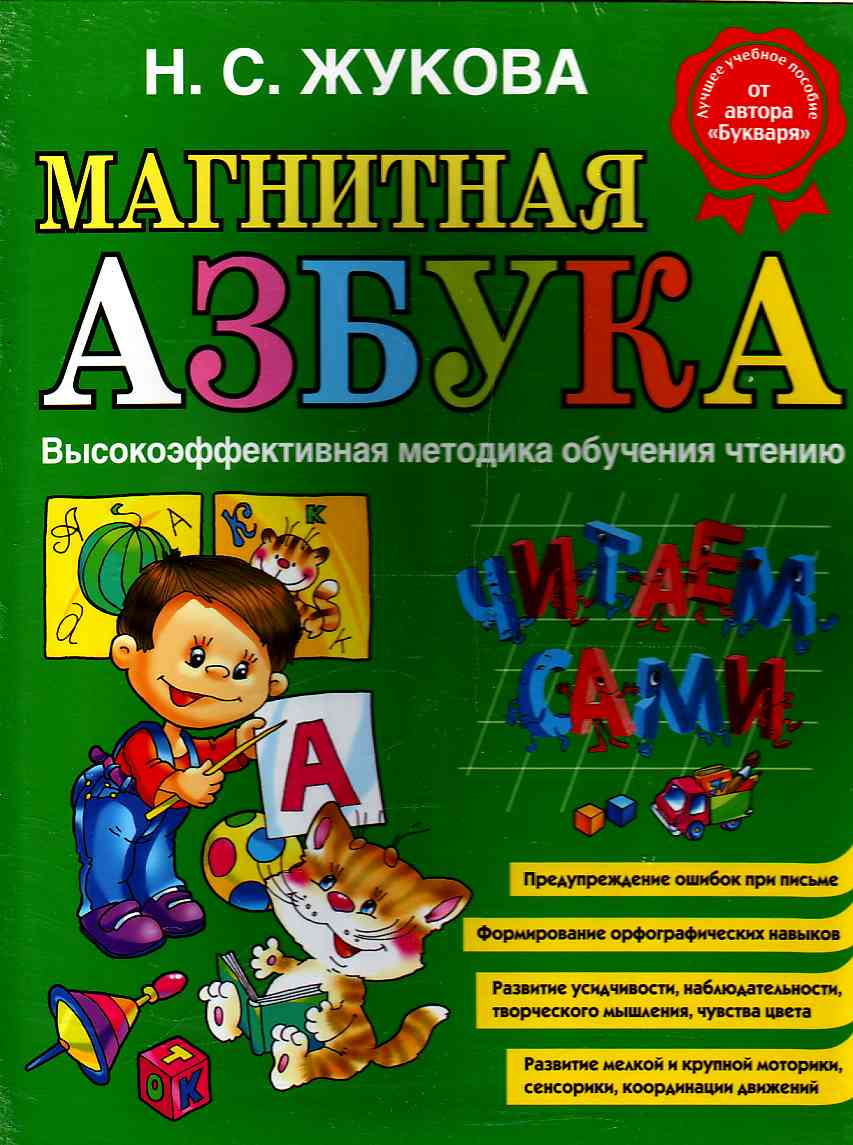
Magnetic Alphabet Zhukova
Parents who decide to follow one of the author's methods of teaching reading should follow the recommendations of their developers. And for those who decide to teach a child to read in the old fashioned way, there is not much choice. They have to memorize the alphabet first, and only then start reading. It is advisable to show letters to a child from the age of two or three.
In another step, all these elements are associated with the meaning of words and text. Reading is not just about saying words or making connections between phonemes and graphemes. It is necessary to understand the ideas that the text conveys. Drausio: Does it depend on training? It is very important to install good relationship between the therapist and the child who needs to be treated, who needs to understand what is being done to him. An important step in the evolution of the case is given when she begins to choose the treatment herself and suggests the actions that she wants to do.
Within certain limits, this provides best forecast. After child education children move on to a new stage school life: elementary education. With him comes the biggest problem at this stage: pre-literacy. This new stage starts when the child finishes 6 or 7 years old, but is also the result of a process in which the family can contribute and much so that the child has peace at this stage.

The original way to memorize letters
An important point: the consonants with the child are memorized as they are read in the word - without the overtone "e". It is correct to pronounce "r" and not "re" or "er". If this rule is not followed, the child will read the syllable "ra" as "rea" or "era".
We spoke with our partners in the mediation space, psychologists Michel Klaumann and Daniel Gross de Freitas. They prepared 7 tips for families with pre-literacy children. The first significant change in children's lives is the transition from education preschool education in primary education, which in social terms means the need for transformation in the lives of children. Sometimes they are even associated with a change in school, which requires even more adaptation on their part. Here's a tip: don't push the kids by scaring them, "next year will be different, you'll have to get into the rules and study to learn how to read and write."
Learning letters is facilitated by their visualization. Cubes with letters, a magnetic alphabet, an interactive poster with an alphabet - any auxiliary equipment will come in handy. To begin with, the child needs to be taught to quickly look for the desired letter among the proposed ones. Later, with it, you can lay out a letter from sticks or matches, sculpt it from plasticine and, finally, write it. For those who confuse letters, it would be correct to suggest touching their three-dimensional images with eyes closed. Tactile sensations help memorization.
Ideally, the conversation should encourage their maturation, for example: Pull up, you are already approaching 6 years old, so next year there will be very interesting news, you will begin to discover letters, words and many other knowledge that children at this age love.
When the year begins, the main attitude of parents is to know the chosen methodology regarding the literacy process. Exist different ways teaching children to read and write, some of which we will summarize below. Thus, most of us learned the traditional alphabetical method, in which the "Soft Way" was useful tool supports where letters were memorized, first vowels and then consonants, and after syllabic families worked to form words.

It is necessary to follow the correct pronunciation of sounds
Tip: when memorizing vowels, it is important to pay the child's attention to the sound reproduction scheme. For example, "A" - the mouth is wide open, "y" - lips with a tube, "e" - the mouth is stretched to the sides.
Separate rules regarding memorization of letters
It is important to encourage the child to listen to the words and look for the right sounds in them. If the letter “o” is memorized, you can name the child the words that begin with it: cloud, deer, donkey. To check how well the lesson is learned, interspersed with words on “o”, it is correct to offer the child words that begin with other letters. In a similar way, a child can quickly be taught to find the right letter at the end and in the middle of a word.
The background method is used in many schools and its main concept is learning through association between sounds and letters. He is taught to encode speech in a written language and decipher writing through spoken language and thoughts. Playful actions are used to facilitate necessary associations as well as meaningful words, images, characters and stories.
The use of the constructivist method is increasing more and more, because it is a method that is associated with the whole, and not with parts of words. Children are motivated to write what they want without worrying about spelling rules and perfect syntax, so they create small texts that make sense to them. As they try to write or read they run into problems, and then the facilitator uses learning tools to help the children find solutions to their problems without using spelling letters, for example to practice repeating syllables.
It is important to know: it is easiest for a child to single out the initial vowel in a word (especially if it is stressed). It is relatively easy to indicate the final consonant. At the same time, it is very difficult for a baby to distinguish the initial consonant and the last vowel.
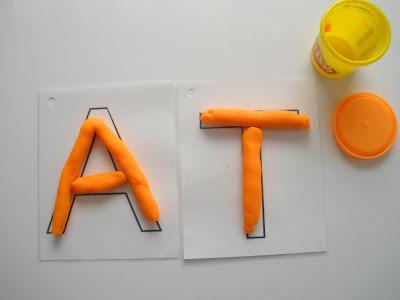
Sculpting letters helps you remember them faster
Once this is done, it's best to follow the rules of the school from your method. If the school offers a constructivist method, the intervention at home, for example, may not be writing letters, but helps children perceive other words written with the same sound that initiates the word one wants to write, for example. It is not a matter of a deep understanding of the method, but of an understanding of the practice of the school, so that a rapprochement takes place in the home, and the child can better use all the stimuli offered.
In general, during homework support for adults will consist of reading the statements and support in understanding what needs to be done. When it comes to completing a lesson, let your child do it autonomously and put down your own attempts on paper without your intervention. Don't get carried away with the idea that a child has to take the right lesson at school, it is very important that teachers understand the difficulties a child has at home. So: don't do this for your child!
It is useful to write letters with paints, felt-tip pens with the child. It is important that in your imagination, when identifying a sound and a letter, it is not limited to a certain size or color. You can show different fonts in newspapers, on containers and packaging, on signs, etc.
Tip: a child under 6 years old should definitely not be confused by offering him to read capital letters along with printed ones.
Moreover, you should not teach a preschooler to write in cursive at home. Skills acquired at home may not match the teacher's ideas regarding slope, continuous or separate writing, connection method, and the like.
Reading syllables
It is important that in the perception of a child of 5-6 years old, it is the syllable, and not a single letter, that becomes the unit of reading. The letter combination should be perceived by the preschooler as a single graphic element. If you do not pay enough attention to this issue, the skill of reading syllables and words by letter can be fixed in a child for a long time. This will prevent him from reading syllables and perceiving words. A child who has mastered the wrong method of reading will still have to be retrained in the end.
It is worth trying the following method of learning to merge letters into one syllable. One letter is written at the beginning of the line, the other - at the end. A connecting arrow is drawn between them. The child is invited to slowly lead along it with his finger and all this time “pull” (pronounce) the first sound. The second sound is enough to pronounce briefly. Example: ARU is pronounced as "aaah", NðO as "nnno".
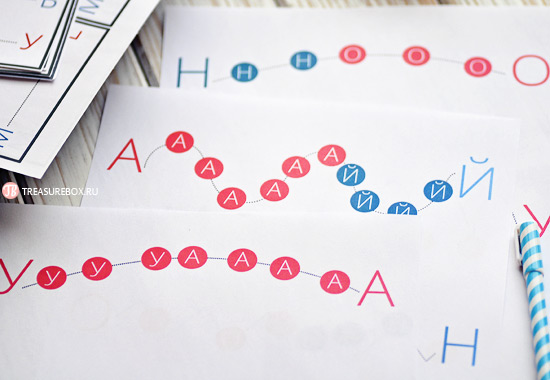
Conducting syllables help continuous pronunciation
As a result of such training, the child must independently, moving his finger along the connecting line, freely read syllables of two letters. Syllables should be offered to the child in the following order:
- consisting of vowels (ao-, ua-);
- open, consisting of one consonant and one vowel (on-, yes-);
- closed, consisting of one vowel and one consonant (an-, em-).
Many children find it difficult to determine the sequence of letters in one syllable. For example, "am-" they can read as "ma-" or vice versa. The ability to correctly combine letters in a two-letter syllable must be brought to automatism. It is possible to offer the reading of three- and four-letter syllables only to preschoolers who can read two-letter syllables together and freely.
Reading syllables should not be considered only as preparation for reading words. Reading syllables, especially complex and unusual ones (shpy, vpu, smoh, zdra) trains the skills of correct pronunciation. Unlike words, the child does not mentally connect abstract syllables with anything, so reading syllables eliminates the temptation to read at random.

Pictures help speed reading
Tip: in parallel with reading, it is worth teaching a 6-year-old child to contrast syllables with hard and soft consonants (ma-me, well-nu, ko-kyo). This will help your child write them correctly in school.
Reading the words
Traditionally, words consisting of two repeated two-letter open syllables such as "mother" and "dad" are considered the simplest. Children who have previously trained to read complex syllables will easily master words consisting of one sentence (cat, cancer, sleep, chorus, bow).
When reading words, children may have problems with the placement of stress. This problem does not have a universal solution. When reading a word, the child will have to “recognize” it. There is only one way to provide him with such an opportunity - by expanding his horizons and vocabulary. It is important that the parent controls the child's understanding of the meaning of the words read.

Reading words by syllables - flashcards
Tip: if the child has problems moving from syllables to words, it is worth simplifying the task for him and dividing the words into syllables with dashes.
Example: mu-ha, lu-na, elephants, string-on. If the child does not have such problems, you can immediately read the words written together.
Reading sentences
A kid of 5-6 years old quickly realizes that a sentence is a complete thought. At this stage, it's time to introduce the child to punctuation marks (".", "!", "?"). According to them, a small reader should navigate where the sentence ends. To begin with, it is worth offering the child sentences consisting of two words like "Kolya is walking."

The transition to reading sentences is the easiest
The main difficulty in reading sentences is to remember the previous words while reading the next ones. The best way to teach a child to make a sentence of three words is as follows.
The first word is read. The child must remember it. Repeating it from memory, he reads the second word and remembers it too. Next, the baby repeats the first and second word from memory and reads the third. This is how the compilation and understanding of the proposal as a whole is achieved.
Mistakes that parents make when teaching a child to read:
1. We begin to learn not words, but letters.
Letters for a child are something completely incomprehensible and abstract. For it is much easier to remember the spelling of familiar words, such as the favorite word "mother", than the unknown letters "a", "o". Yes, and try, explain to the child - what is this "o"? Therefore, teach him not to memorize letters, but to read whole words. How to do this is described below.
2. The main thing is to teach the child not letters from the alphabet, but sounds, as they will be heard in words. Not "be", but "b". Not "sha", but "sh". Otherwise, your baby will not read the words correctly, that is, not “dad”, but “peapea”.
3. Study should bring joy and pleasure. You can’t force a child to learn to read, otherwise you can once and for all discourage him from learning something, the baby will form a negative idea about learning in general.
4. Do not teach a child to read before the age of 5. Although many mothers aspire to early development their children, medical science has proven what early learning reading can lead to dyslexia (persistent errors in reading) and serious difficulties in writing and reading later on. As you know, only 20% of children under 5 years old can read. And from the point of view of the modern world, 30% of children by the age of 8, and 70% by the age of 6-7 years have the full maturation of the parts of the brain necessary for reading and the ability to safely learn to read. Up to 5 years, better develop with your child fine motor skills, logical, spatial thinking, etc. And leave the reading for later.
5. When, in your opinion, the baby is already ripe for learning to read, then introduce your activities gradually, but systematically. Start with 3 minutes a day, increasing the time by a couple of minutes every day (up to 45 minutes per lesson maximum - provided you and your child are in a good mood). Classes are held daily, weekends are sometimes possible. The main thing is a positive attitude in the baby. Success comes only in emotionally attractive pursuits.
There are many methods by which you can teach your child to read. But the best one is the one that suits you and your baby personally. In the process of various games and activities, you will surely understand what exactly your child is most interested in, and start from this when choosing your methodology. 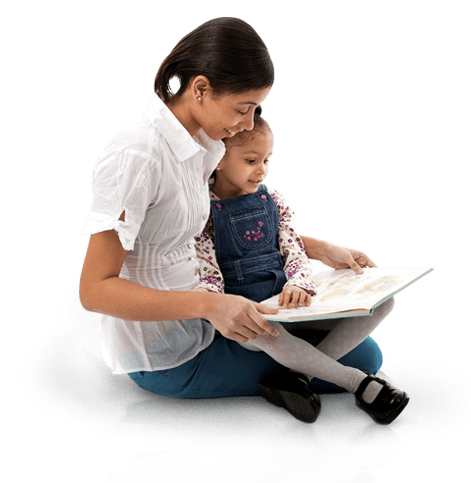
I want to give a few examples - where you can start teaching a child to read.
1. Draw letters on cardboard cards, cut them into two parts and let the kid collect such letter puzzles, so he will get acquainted with the letters. When the child can easily complete this task, you can complicate it - cut the letters into 4 parts.
2. Dominoes - syllables. We also make dominoes from cardboard - it is necessary that the child learns to find the same syllables during the game. When he masters this, complicate it - you will need to collect words from familiar syllables.
3. Cards with words. Use a thick red (to draw attention) marker in large letters on white cardboard cards. On the first day, show and read 5 words to the baby (2 seconds per card), do not explain anything, do not ask him to repeat, just show the word and say: (for example) "This means a table." Be sure to praise him for his attention, kiss him, your physical contact is important. Repeat this exercise 2 more times with an interval of 30 minutes. Add 2 new words every day. Up to 15 words, then replace old words with new ones - once every 3 days. It is advisable to start learning with the simplest and known to the child words. We will finish later with phrases and sentences.
4. You can cut out letters from felt or fabric and collect words with your baby.
5. Many kids like applications, so let them be applications - letters. It is not necessary to glue the paper, experiment with pieces of fabric, glue buttons, rice, beans, shells, etc. 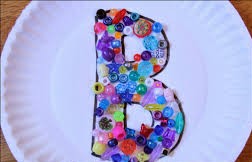
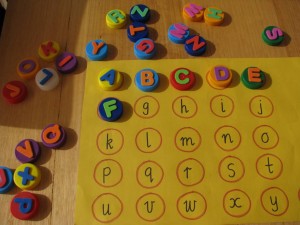
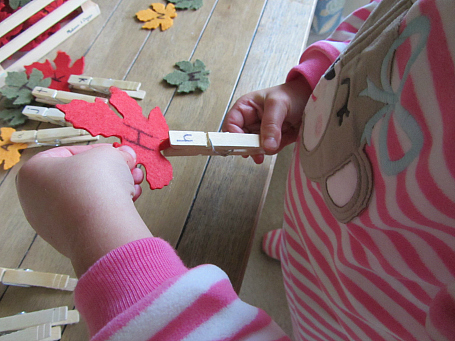
![]()

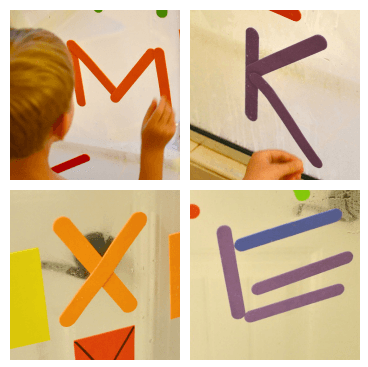
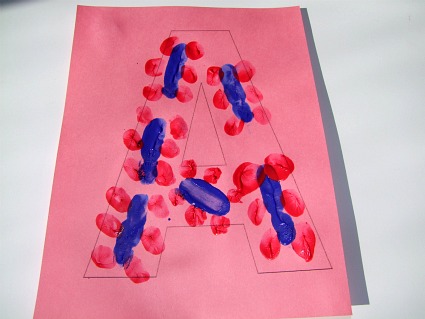
And remember, the more fun your classes are, the more enthusiastic your baby will be in learning. I wish you to teach your child with pleasure and without problems, and it doesn’t matter if he is 5 years old, he is 6, 7 or 8.
